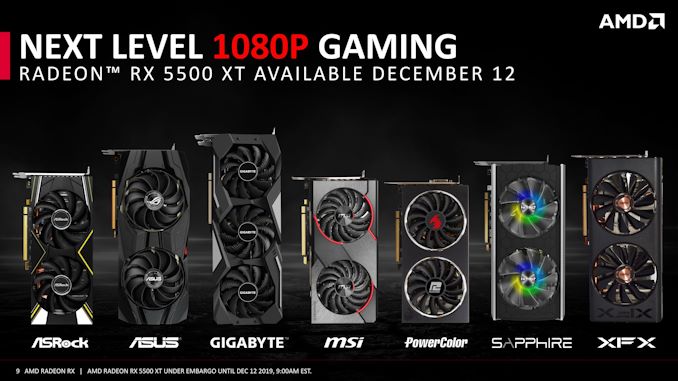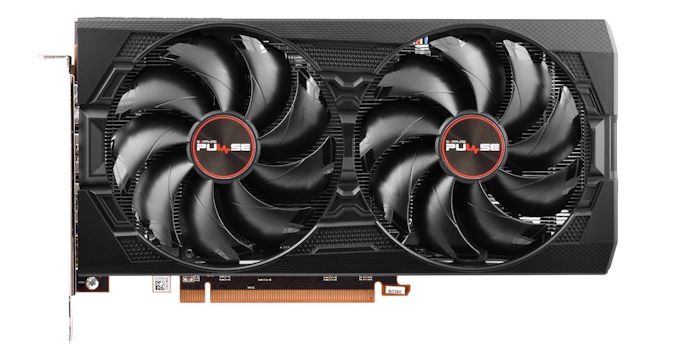The AMD Radeon RX 5500 XT Review, Feat. Sapphire Pulse: Navi For 1080p
by Ryan Smith on December 12, 2019 9:00 AM ESTClosing Thoughts
While the launch of the Radeon RX 5700 series and the underlying Navi 10 GPU was not a slam dunk for AMD’s GPU division, it was none the less an important achievement. The combination of the new RDNA core architecture as well as TSMC’s 7nm process gave AMD a significant kick in both performance efficiency and power efficiency. And in the process, it set a template for all the Radeon RX 5000 series cards to follow.
So it shouldn’t be too surprising then that the new Radeon RX 5500 XT gets to enjoy much the same situation. Compared to AMD’s previous generation Polaris-based RX 500 series cards, the 1080p-focused RX 5500 XT delivers better performance, and it does so while drawing noticeably less power. Even compared to their NVIDIA rivals, AMD is generally competitive on power efficiency in a class of cards where they were well behind in the previous generation.
Competitive performance, meanwhile, is a bit of a trickier subject. As the replacements to the RX 570/580/590 within AMD’s stack, the RX 5500 XT almost always beats AMD’s older cards, the one odd exception to this being Metro Exodus. As a result, AMD’s cheaper 4GB RX 5500 XT looks especially good here, reaching performance parity with NVIDIA’s recently launched and similarly priced GeForce GTX 1650 Super. As is usually the case, the cards are anything but equal on a game-by-game basis, constantly trading wins and losses, but at the end of the day they’re fighting over the same market with the same performance.
The 8GB RX 5500 XT, on the other hand, faces tougher competition. The extra VRAM helps to boost its performance and its price, putting it in competition with NVIDIA’s somewhat awkwardly placed GTX 1660. The GTX 1660 is an odd man out as the only current-generation GDDR5 card among the contenders, and yet it’s still fast enough to remain several percent ahead of the 8GB RX 5500 XT. To be sure, AMD’s new card puts up a great fight, coming closer to meeting NVIDIA in both performance and power efficiency than any previous AMD card; but at the end of the day it’s not enough to completely close the gap with NVIDIA’s closest competitor. Which is not to say that the RX 5500 XT is entirely outclassed here, but the GTX 1660 leads by just enough that it can’t be entirely ignored.
| Performance Summary (1080p) | ||||
| Relative Performance | Relative Price |
|||
| RX 5500 XT 4GB vs GTX 1650S | 0% | +6% | ||
| RX 5500 XT 8GB vs GTX 1660 | -8% | -5% | ||
| RX 5500 XT 8GB vs RX 580 8GB | +8% | +11% | ||
| RX 5700 vs. RX 5500 XT 8GB | +60% | +60% | ||
Throwing a wrench into all of this however – for both AMD and NVIDIA – is VRAM capacity. VRAM isn’t cheap, and GDDR6 even less so, so both vendors are using VRAM capacity as product differentiators and to upsell their better cards. But as VRAM capacity in the $150-$200 price range has been pretty stagnant for the last couple of years now, I do have some concerns about the long-term implications for the 4GB RX 5500 XT, especially with the next-generation consoles set to launch in a year’s time. With the consoles setting the baseline for most multiplatform games, it’s a reasonable bet that VRAM requirements aren’t going to stay put at 4GB much longer. So while the 4GB RX 5500 XT is a great value now, I suspect it’s going to run out of VRAM well before its compute performance gets to be a bottleneck. And while NVIDIA’s GTX 1660 fares better here with its 6GB of VRAM, 6GB is still not 8GB.
Overall then, the VRAM situation adds an extra wrinkle to any kind of product recommendations, as it’s one more variable that deserves consideration.
At the end of the day, I don’t think any 4GB cards are a great choice right now. For buyers who absolutely cannot afford to spend more than $169, then the 4GB RX 5500 XT or NVIDIA’s GeForce GTX 1650 Super counterpart are both going to be the best choices you can make right now, at least among the current-generation cards. However, spending another $30 to get a better card is going to get you a card with at least 6GB of VRAM and 6% more perforamnce, and that’s going to remain relevant for a lot longer than a 4GB card will in 2020.
Choosing between the 8GB RX 5500 XT and GTX 1660, on the other hand, is a bit harder. AMD has a 2GB VRAM advantage, which is likely to be helpful in the future; but right now they can’t match NVIDIA’s performance or feature advantage. Ultimately I’m not sure there’s a clearly correct answer here – at least, not one that can be backed entirely with hard data. In the meantime however, as the second to market it's up to AMD to make a convincing showing if they want to dislodge NVIDIA's existing GTX 1660.
As for Sapphire’s Pulse RX 5500 XT in particular, it’s hard to envision a better card to show off the Radeon RX 5500 XT. If you can look past the card’s somewhat ridiculous size for its class, the product as a whole is just about everything you could want out of a reference clocked card. The build quality is solid, the included TriXX software is handy, and the acoustics are incredible. It may not be a silent card, but with two giant fans to push plenty of air with ease, it may just as well be.
And with that, AMD is set to wrap up their GPU lineup for 2019. At only 3 Navi cards in, AMD is far from done in fleshing out a complete, top-to-bottom family of video cards. But for now, AMD is able to hit the mainstream and performance segments, which is a good place to stop for a bit and reflect as we go into the holidays.












97 Comments
View All Comments
Korguz - Friday, December 20, 2019 - link
and nvidia will price most of their cards out of reach of most people.. like a large chuck of then are now.... do they need to charge that ?? probably not.. but they do... cause they can.. just like intel before zen...Kangal - Friday, December 20, 2019 - link
Not quite.Before, in the early 2000-2005 period the Internet was not as accessible and pronounced as it is today. And to add to that, when it came to "perception" things like marketing were very effective. So despite AMD producing some of the best CPUs and GPUs at the time, they weren't winning. Intel and Nvidia had the mindshare, thanks to their large marketing departments.
Now?
There's Facebook and YouTube. Information is much more accessible, anyone can find more details about a product from more trusted third-party professionals. And on top of that, the past few years has changed the public's mindshare about AMD. They're now seen as the better CPU company, so that trickle downs to their perception of GPUs as well. It is no longer a "poor mans Nvidia".
So what am I saying?
The more things change, the more they stay the same. The market will always have winners and losers. However, this time AMD is under new management and heading a new direction, and they have seized a real opportunity to turn things around. That might mean AMD only releasing a few cards, and instead focusing their attention to things that make money: servers and consoles. I'm fine with that, and if things kind of sour, well it was the (sheep) public's fault for allowing the monopoly to arise by not being more critical and skeptical (think pre-1950's attitude). However, I should also add that just because there is a monopoly does not mean the market isn't healthy or competitive or that it's bad for the consumer; it is likely to be the case but not a certainty.
Korguz - Friday, December 20, 2019 - link
nvidia had the mindshare.. but intel has its bribes and threats....either way.. unless amd can make a zen2 equivalent for radeon, nvidia will still over charge and price some of their cards out of reach of most people, like they already have done
Gemuk - Thursday, December 12, 2019 - link
I'd argue that it wasn't AMD selling RX 570 and RX 580 for cheap that has distorted the market, rather it was the consumer's acceptance of the higher pricing across the board. Price/perf needle has barely moved up after three years. It is the new norm. We're never going back to those days, are we?Yojimbo - Thursday, December 12, 2019 - link
Price/performance has moved up since 3 years ago. 3 years ago a 1060 cost about what a 1660 Ti costs now, and a 1660 Ti is about 36% faster than a 1060. You are getting over 30% increase in performance per price, even if you throw out what happened to 1060 prices because of the crypto craze and spike in DRAM prices. The gain in performance per dollar from the 960 to the 1060 was about 44%. So it's lesser this generation but I don't think the difference qualifies as "barely moved up" and you can't take one example and call it a trend. As for the RTX cards, of course with NVIDIA taking up die space on new features that don't go into price/performance calculations there is going to be a drag on the numbers that get spit out.AMD were selling the 570 and 580 for cheap because they had a bunch of them in inventory from the crypto hangover and they needed to get as much revenue for them as they could. If it took too long they would lose more value and they'd have to delay the 5500.
Alistair - Thursday, December 12, 2019 - link
you mean 1660 super is the same price as the 1060, the 1660 ti is still more expensive than the old 1060 from years agojabbadap - Thursday, December 12, 2019 - link
gtx1060 FE 6GB msrp was $299 same as gtx1660ti. While gtx 1060 6GB has "msrp" of $250, finding AIB sku priced as such was near to non-existent. Norm was $299 and more like gtx1660tis.1660 Super is $229, which is lower than any official price point nvidia gave to gtx1060 6GB cards.
HardwareDufus - Thursday, December 12, 2019 - link
Had one of my 24" 1920x1200 monitors fail the other day, and the other has a few lines. Therefore, I purchased 2 32" 4K monitors. Should arrive in days.Thinking about purchasing a discreet video card as my current I7-3770K with its IGP won't drive these new moniros to 4K resolutions.
I don't game, so I would imagine I'd received satisfactory performance with an inexpensive 5500XT card to drive both these monitors at 4K for really good size/readability of text?
Comments?
haukionkannel - Thursday, December 12, 2019 - link
For that usage... sure. But no Gaming unles you use 50% scaling. With 50% scaling and amd sharpening, even Gaming is good.Zoomer - Saturday, December 21, 2019 - link
Don't need sharpening with 50% scaling. Pixels will just be 4 times as big and map perfectly.